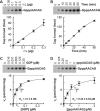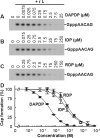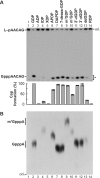5'-Phospho-RNA Acceptor Specificity of GDP Polyribonucleotidyltransferase of Vesicular Stomatitis Virus in mRNA Capping
- PMID: 28053102
- PMCID: PMC5331801
- DOI: 10.1128/JVI.02322-16
5'-Phospho-RNA Acceptor Specificity of GDP Polyribonucleotidyltransferase of Vesicular Stomatitis Virus in mRNA Capping
Abstract
The GDP polyribonucleotidyltransferase (PRNTase) domain of the multifunctional L protein of rhabdoviruses, such as vesicular stomatitis virus (VSV) and rabies virus, catalyzes the transfer of 5'-phospho-RNA (pRNA) from 5'-triphospho-RNA (pppRNA) to GDP via a covalent enzyme-pRNA intermediate to generate a 5'-cap structure (GpppA). Here, using an improved oligo-RNA capping assay with the VSV L protein, we showed that the Michaelis constants for GDP and pppAACAG (VSV mRNA-start sequence) are 0.03 and 0.4 μM, respectively. A competition assay between GDP and GDP analogues in the GpppA formation and pRNA transfer assay using GDP analogues as pRNA acceptors indicated that the PRNTase domain recognizes the C-2-amino group, but not the C-6-oxo group, N-1-hydrogen, or N-7-nitrogen, of GDP for the cap formation. 2,6-Diaminopurine-riboside (DAP), 7-deazaguanosine (7-deaza-G), and 7-methylguanosine (m7G) diphosphates efficiently accepted pRNA, resulting in the formation of DAPpppA, 7-deaza-GpppA, and m7GpppA (cap 0), respectively. Furthermore, either the 2'- or 3'-hydroxyl group of GDP was found to be required for efficient pRNA transfer. A 5'-diphosphate form of antiviral ribavirin weakly inhibited the GpppA formation but did not act as a pRNA acceptor. These results indicate that the PRNTase domain has a unique guanosine-binding mode different from that of eukaryotic mRNA capping enzyme, guanylyltransferase. IMPORTANCE mRNAs of nonsegmented negative-strand (NNS) RNA viruses, such as VSV, possess a fully methylated cap structure, which is required for mRNA stability, efficient translation, and evasion of antiviral innate immunity in host cells. GDP polyribonucleotidyltransferase (PRNTase) is an unconventional mRNA capping enzyme of NNS RNA viruses that is distinct from the eukaryotic mRNA capping enzyme, guanylyltransferase. In this study, we studied the pRNA acceptor specificity of VSV PRNTase using various GDP analogues and identified chemical groups of GDP as essential for the substrate activity. The findings presented here are useful not only for understanding the mechanism of the substrate recognition with PRNTase but also for designing antiviral agents targeting this enzyme.
Keywords: GDP polyribonucleotidyltransferase; L protein; cap structure; mRNA capping; nonsegmented negative-strand RNA viruses; rabies virus; vesicular stomatitis virus.
Copyright © 2017 American Society for Microbiology.
Figures






Similar articles
-
RNA Synthesis and Capping by Non-segmented Negative Strand RNA Viral Polymerases: Lessons From a Prototypic Virus.Front Microbiol. 2019 Jul 10;10:1490. doi: 10.3389/fmicb.2019.01490. eCollection 2019. Front Microbiol. 2019. PMID: 31354644 Free PMC article. Review.
-
Histidine-mediated RNA transfer to GDP for unique mRNA capping by vesicular stomatitis virus RNA polymerase.Proc Natl Acad Sci U S A. 2010 Feb 23;107(8):3463-8. doi: 10.1073/pnas.0913083107. Epub 2010 Feb 8. Proc Natl Acad Sci U S A. 2010. PMID: 20142503 Free PMC article.
-
In vitro capping and transcription of rhabdoviruses.Methods. 2013 Feb;59(2):188-98. doi: 10.1016/j.ymeth.2012.05.013. Epub 2012 Jun 8. Methods. 2013. PMID: 22687619 Free PMC article. Review.
-
Signature motifs of GDP polyribonucleotidyltransferase, a non-segmented negative strand RNA viral mRNA capping enzyme, domain in the L protein are required for covalent enzyme-pRNA intermediate formation.Nucleic Acids Res. 2016 Jan 8;44(1):330-41. doi: 10.1093/nar/gkv1286. Epub 2015 Nov 23. Nucleic Acids Res. 2016. PMID: 26602696 Free PMC article.
-
Formation of guanosine(5')tetraphospho(5')adenosine cap structure by an unconventional mRNA capping enzyme of vesicular stomatitis virus.J Virol. 2008 Aug;82(15):7729-34. doi: 10.1128/JVI.00326-08. Epub 2008 May 21. J Virol. 2008. PMID: 18495767 Free PMC article.
Cited by
-
RNA Synthesis and Capping by Non-segmented Negative Strand RNA Viral Polymerases: Lessons From a Prototypic Virus.Front Microbiol. 2019 Jul 10;10:1490. doi: 10.3389/fmicb.2019.01490. eCollection 2019. Front Microbiol. 2019. PMID: 31354644 Free PMC article. Review.
-
Transcriptional Control and mRNA Capping by the GDP Polyribonucleotidyltransferase Domain of the Rabies Virus Large Protein.Viruses. 2019 Jun 1;11(6):504. doi: 10.3390/v11060504. Viruses. 2019. PMID: 31159413 Free PMC article. Review.
-
RNA regulatory processes in RNA virus biology.Wiley Interdiscip Rev RNA. 2019 Sep;10(5):e1536. doi: 10.1002/wrna.1536. Epub 2019 Apr 29. Wiley Interdiscip Rev RNA. 2019. PMID: 31034160 Free PMC article. Review.
-
GDP polyribonucleotidyltransferase domain of vesicular stomatitis virus polymerase regulates leader-promoter escape and polyadenylation-coupled termination during stop-start transcription.PLoS Pathog. 2022 Feb 2;18(2):e1010287. doi: 10.1371/journal.ppat.1010287. eCollection 2022 Feb. PLoS Pathog. 2022. PMID: 35108335 Free PMC article.
-
The complete pathway for co-transcriptional mRNA maturation within a large protein of a non-segmented negative-strand RNA virus.Nucleic Acids Res. 2024 Sep 9;52(16):9803-9820. doi: 10.1093/nar/gkae659. Nucleic Acids Res. 2024. PMID: 39077935 Free PMC article.
References
-
- Ogino T, Banerjee AK. 2011. mRNA capping by vesicular stomatitis virus and other related viruses, p 79–94. In Luo M. (ed), Negative strand RNA virus. World Scientific, Singapore.
MeSH terms
Substances
Grants and funding
LinkOut - more resources
Full Text Sources
Other Literature Sources
Miscellaneous

